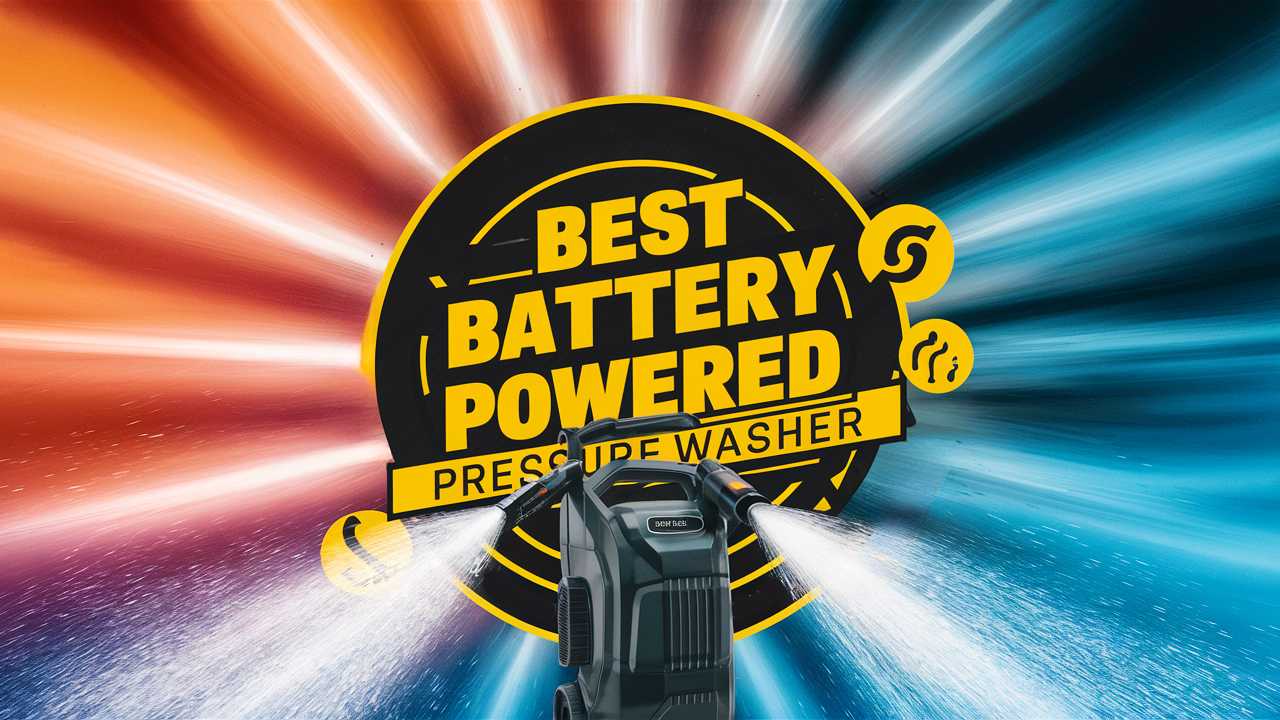In this guide, we’ll explore essential factors to consider when selecting the perfect battery-powered pressure washer for your needs, as well as tips for using and maintaining it effectively.
Best Battery Powered Pressure Washer
| Image | Name | Rating | Shop |
|---|---|---|---|
 | EGO Storm |  | |
 | FlexPro550C |  | |
 | Greenblast |  |
EGO Storm
The EGO Power+ HPW3204-2 cordless pressure washer is a standout choice for those seeking a powerful cleaning solution without the hassle of cords. With its Peak Power technology, this unit can reach up to 3200 PSI at 1.2 GPM (with optional 2.0 GPM) using two included 6.0Ah ARC Lithium batteries, providing efficient and effective cleaning.
This pressure washer offers a range of customizable settings, including ECO, High, and Turbo modes, as well as real-time battery charge monitoring via its wand-integrated display. Additionally, the device features quick setup and breakdown points for the hose and wand, making it easy to transport and store when not in use. The included accessories, such as a 25-foot high-pressure hose, stainless steel wand, and filter, expand the tool’s versatility even further.
FlexPro550C
The Fanttik NB8 Ultra Cordless Pressure Washer is a top-notch option for those seeking convenience and power in their cleaning tasks. With its impressive battery life of up to 58 minutes, this cordless pressure washer allows for extended use without the need for recharging or cord placement issues. The built-in wheeled pull-rod carts make it easy to transport and move around.
The Fanttik NB8 Ultra offers a range of features that set it apart from traditional single-pressure washers. Its 5-in-1 nozzle allows for precise cleaning in various situations, while the energy-saving mode, standard mode, and strong mode cater to different use cases. Additionally, the LED screen displays real-time information about pressure flow, power, and mode, providing full transparency and control over the cleaning process.
Greenblast
This Greenworks 24V portable power cleaner is a great option for anyone looking for an easy-to-use battery-powered pressure washer. With its adjustable nozzle feature, you can switch between different spray patterns to suit your cleaning needs, from heavy-duty dirt removal to gentle watering.
This unit delivers powerful performance with up to 600 PSI max and 0.8 GPM max, making quick work of even the toughest messes. The included accessories, such as a utility bristle brush and extension wand, add to its versatility, allowing you to tackle hard-to-reach areas or scrub away stubborn dirt. Plus, with the option to use either a 24V or 48V battery, you have flexibility in your cleaning setup.
Ego Blast Plus
The EGO POWER+ Electric Pressure Washer is a top-notch option for anyone in need of a battery-powered cleaner. This unit boasts an impressive 2,100 PSI rating with a water flow rate of up to 1.2 GPM, making it perfect for tackling tough cleaning jobs both indoors and outdoors.
One of the standout features of this pressure washer is its compact design, which allows for easy portability and storage. It can be connected directly to a garden hose or draw from a fresh water source, giving you maximum flexibility. Additionally, the quick connection points make setup and breakdown a breeze. The kit includes a range of nozzles (15-degree, 25-degree, 40-degree, and turbo) in order to tackle various cleaning tasks with ease.
How To Choose a Battery Powered Pressure Washer
Choosing the right battery-powered pressure washer can feel overwhelming with the many options available on the market today. These tools are becoming increasingly popular due to their portability, ease of use, and reduced environmental impact compared to gas-powered models.
Understanding Battery-Powered Pressure Washers
Before diving into the selection process, it’s crucial to understand what battery-powered pressure washers are and how they differ from conventional electric or gas-powered models. Battery-powered pressure washers are cordless cleaning tools that utilize rechargeable batteries, allowing users the flexibility to tackle outdoor chores without being tethered to a power outlet or the noise and emissions associated with gas engines. They are particularly useful for light to moderate cleaning tasks, such as washing cars, patios, decks, and garden furniture.
Assess Your Cleaning Needs
The first step in choosing a battery-powered pressure washer is to assess what you’ll primarily be using it for. Different tasks require different levels of power and features:
Light Cleaning: If you intend to wash vehicles or lightly clean outdoor furniture, a model with lower PSI (pounds per square inch) and GPM (gallons per minute) might suffice. Most battery-powered models will do well with a rating of around 1,300 to 1,600 PSI for these tasks.
Medium Cleaning: For more significant cleaning jobs, such as cleaning wooden decks, patio furniture, or concrete surfaces, look for a washer with 1,600 to 2,000 PSI. This power will effectively remove dirt, mildew, and other debris.
Heavy Cleaning: If you expect to tackle tough stains or large areas frequently, consider a high-performance model that offers higher PSI (up to 2,500 or more) and a robust GPM rating. Keep in mind that the higher the specifications, the more weight and battery life you may have to account for.
Evaluate Power and Battery Life
Battery life is one of the most critical factors when choosing a battery-powered pressure washer. A longer battery life means less downtime and more cleaning. When evaluating battery performance, consider the following:
Battery Capacity: Check the amp-hour (Ah) rating of the battery. A higher Ah value typically indicates a longer runtime. Look for models that offer interchangeable or swappable batteries if you plan to undertake larger jobs.
Runtime: Manufacturers usually provide information regarding how long a battery lasts under standard cleaning conditions. Aim for models that offer at least 30 to 60 minutes of run time on a single charge for average jobs.
Charging Time: Consider how quickly the battery charges. Some models feature fast-charging capabilities, while others may take several hours to fully recharge. Quick charging can be advantageous for larger projects or multiple cleaning sessions in a day.
Consider Pressure Ratings
Pressure ratings are crucial indicators of a washer’s effectiveness. PSI and GPM are paramount when determining a pressure washer’s cleaning power:
Pounds per Square Inch (PSI): This number represents the cleaning force generated by the pressure washer. For most residential tasks, a PSI of 1,300 to 2,000 is adequate. Specific specialized tasks, like stripping paint or heavy concrete cleaning, require higher pressure.
Gallons per Minute (GPM): This rating indicates the water flow rate. A higher GPM means faster cleaning, especially for larger areas. While PSI represents pressure, GPM gives insight into efficiency. For effective cleaning, a balance of PSI and GPM is essential; a model with 1,500 PSI and 1.5 GPM, for example, will be effective for most light to medium cleaning tasks.
Look for Essential Features
Not all battery-powered pressure washers are built the same; some come with features that can enhance usability and performance. Here are several features to look for:
Adjustable Pressure Settings: Some models allow you to adjust the pressure based on the task. This versatility enables you to switch between delicate surfaces, like cars, and more durable materials, like concrete.
Built-in Detergent Tanks: Integrated detergent tanks simplify the cleaning process. With this feature, you can easily apply soap and rinse it away without needing additional equipment.
Nozzle Variety: Check for models that include multiple nozzle attachments. Different nozzles produce different spray patterns—ranging from a wide fan for washing large areas to a narrow jet for tougher grime—making your cleaning more effective.
Weight and Portability: Consider the weight of the unit and how easy it is to store. A lightweight model with wheels, an extendable handle, or a compact design is easier to maneuver and carry, especially if you have various locations to clean.
Assess Build Quality and Durability
A battery-powered pressure washer may be less robust compared to gas-powered models, but that doesn’t mean you should compromise on quality. Look for:
Materials: High-quality plastics or alloys are preferable for durability. Steel elements may offer greater resilience but also add weight. Ensure the motor enclosure is secure and can withstand frequent outdoor use.
Warranty: A solid warranty can provide peace of mind. Manufacturers confident in their products typically offer longer warranty periods. Look for coverage on both the battery and the unit itself.
Cost-Effectiveness
Battery-powered pressure washers come in various price ranges, with budget-friendly options starting around $150 to $400. While budget models may suffice for occasional use, investing in a more expensive, durable model can be worth it in the long run, particularly for regular use or larger cleaning tasks.
Long-Term Value: Weigh the initial cost against the expected lifespan and maintenance needs. A higher upfront investment may save you time, effort, and additional repair costs down the line.
User Reviews and Brand Reputation
Before making your purchase, check user reviews and the reputation of the brand. Real-world experiences can provide insights into reliability and performance that specifications alone cannot convey:
Look for consistent feedback: Pay attention to common praises and complaints regarding battery life, cleaning power, and customer service. Brands with excellent customer support and responsive service teams can make a big difference if issues arise.
Consider Brand Trust: Well-established brands are often best, as they generally have a proven track record in manufacturing quality products backed by customer service facilities.
Comparative Analysis
Once you’ve narrowed down your choices to a few promising models, it’s helpful to conduct a comparative analysis. Create a simple chart listing the specifications, features, prices, and user reviews of each model. This visual aid can make it easier to judge which pressure washer aligns best with your cleaning needs and budget.
Safety Precautions
Using a pressure washer, even a battery-powered one, entails certain risks. Here are some crucial safety precautions to keep in mind:
Protective Gear: Always wear safety goggles, gloves, and appropriate clothing. Protecting yourself from debris and high-pressure water is vital.
Understand the Operating Manual: Familiarize yourself with the model’s instructions, safety warnings, and startup procedures. Each unit is unique, so understanding it can prevent accidents.
Proper Stance and Operation: Maintain a steady and balanced stance while operating. Ensure you keep the nozzle directed away from people, pets, and fragile items.
Maintenance Tips for Longevity
To ensure the longevity of your battery-powered pressure washer, implement a routine maintenance schedule:
Clean After Every Use: Rinse off any accumulated debris and dirt from the exterior. Ensure no soap residue is left in the detergent tank.
Battery Care: Follow the manufacturer’s guidelines for battery maintenance. Charge the battery according to the recommended time, and store it in a cool, dry place away from extreme temperatures.
Check for Wear and Tear: Regularly inspect hoses, nozzles, and connections for any signs of wear. Replacing worn-out parts promptly can prevent further damage.
Conclusion
Choosing the right battery-powered pressure washer involves evaluating your specific cleaning needs, assessing power and runtime, exploring essential features, and considering build quality and safety. The right model can transform outdoor cleaning tasks, making them easier and more efficient.






